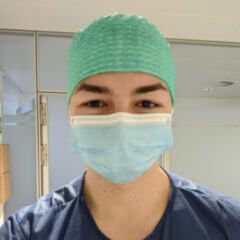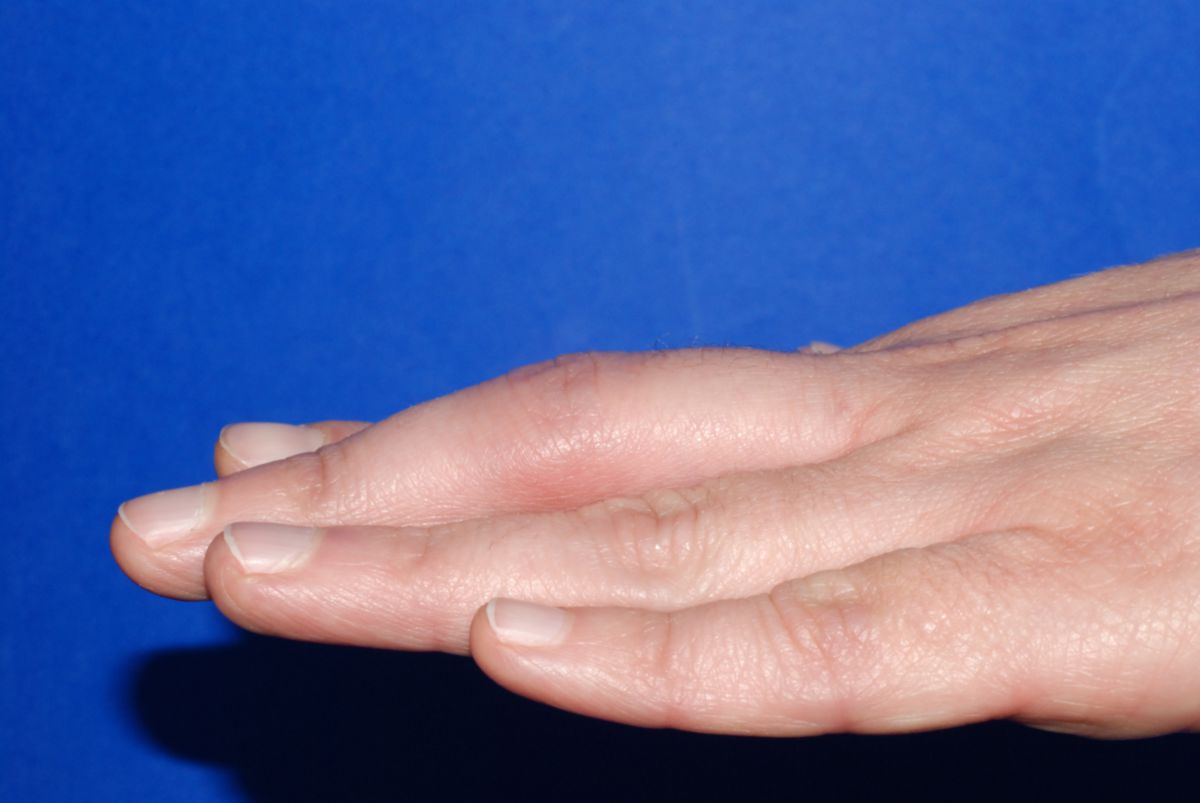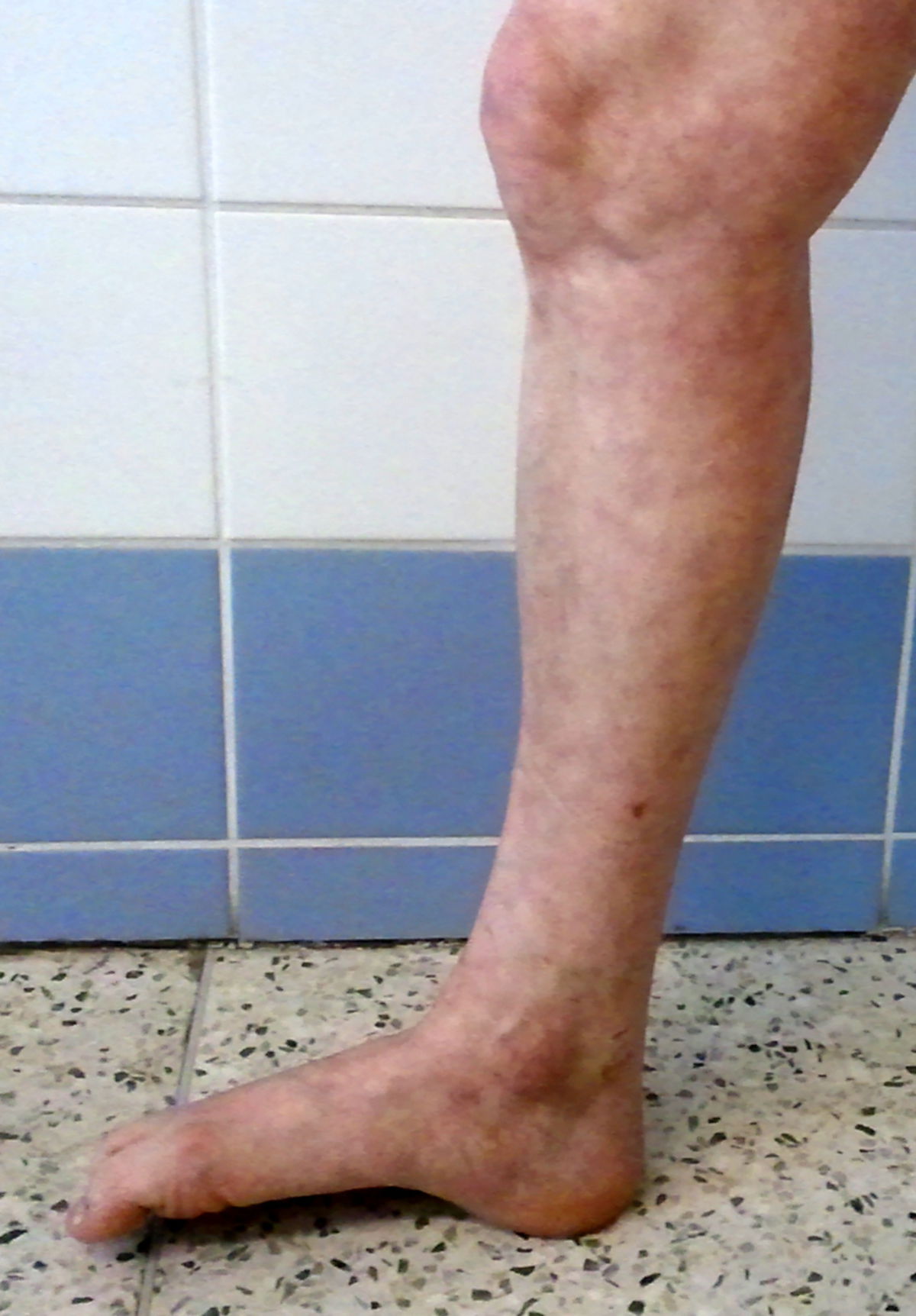CRPS
Synonyme: Morbus Sudeck, Sudeck Krankheit, Sudeck'sche Dystrophie, Sudeck-Dystrophie, Sudeck-Syndrom, Algodystrophie, Sympathalgie, Komplexes regionales Schmerzsyndrom, Sympathische Reflexdystrophie (SRD), Reflex Sympathetic Dystrophy Syndrome (RSD)
Englisch: CRPS
Definition
CRPS, kurz für Complex Regional Pain Syndrome (engl. für komplexes regionales Schmerzsyndrom), ist eine chronische neurologische Erkrankung, die unter anderem mit Schmerzen, Sensibilitätsstörungen und trophischen Störungen einhergeht. Sie tritt nach Weichteil- oder Nervenverletzungen einer Extremität auf, häufig in Zusammenhang mit einer Fraktur oder Quetschung.
- ICD10-Code: G90.5-6
Nomenklatur
Für das CRPS vom Typ I wird häufig noch die ältere Bezeichnung Morbus Sudeck verwendet – benannt nach ihrem Entdecker Paul Sudeck (1866–1945), einem Hamburger Chirurgen.
Pathogenese
Die Pathogenese des CRPS ist nicht vollständig geklärt. Es handelt sich um einen irregulären Heilungsverlauf des verletzten Gewebes. Das Auftreten eines CRPS ist dabei nicht von der Schwere der Verletzung abhängig - die Verletzung kann sogar so geringfügig sein, dass der Patient sich nicht an sie erinnert. Infolge der Verletzung kommt es zu einer Fehlregulation des sympathischen Nervensystems, die den normalen Heilungsverlauf blockiert und stattdessen einen Circulus vitiosus von Schmerz und nachfolgender Sympathikusreaktion in Gang setzt.
Derzeit (Stand 2022) wird diskutiert, dass es bei der CRPS zu einer Entzündungsreaktion kommt, bei der ein Überschuss an Mediatoren (z.B. Substanz P, CGRP) ausgeschüttet wird, der nicht mehr abgebaut werden kann und dadurch die neurogene Entzündungsreaktion verlängert. Diese Dysregulation soll auch im ZNS auftreten, wodurch es ebenfalls zu einer Sensibilisierung der zentralen schmerzverarbeitenden Neuronen kommen soll.
Ähnlich wie beim Phantomschmerz scheint es auch bei der CRPS zu einer Veränderung der neuronalen Verarbeitung der somatosensiblen Reize im Cortex zu kommen ("kortikale Reorganisation"). Diese Mechanismen würden die Ausweitung der Schmerzen über ein bestimmtes neuronales Versorgungsgebiet erklären.
Epidemiologie
Das CRPS tritt nach Frakturen bei etwa 1 bis 2 % der Patienten auf, nach peripheren Nervenverletzungen bei ungefähr 2 bis 5 % der Patienten. Frauen sind häufiger betroffen als Männer, ebenso Personen zwischen dem 40. und 70. Lebensjahr. Die Erkrankung zeigt sich häufiger an den Armen als an den Beinen: Das häufigste Trauma, das eine CRPS auslöst, ist die distale Radiusfraktur. Hier werden Inzidenzen zwischen 7 % und 37 % berichtet.
Symptome
Die Symptome des CRPS sind anfangs unspezifisch und werden oft falsch interpretiert bzw. vom behandelnden Arzt nicht ernst genommen. Sie können darüber hinaus stark variieren. Bei der CRPS handelt es sich jedoch um eine Krankheit, nicht um eine Befindlichkeitsstörung. Typische Krankheitszeichen sind:
Sensorische Störungen
- Brennender oder stechender Ruheschmerz
- Hyperästhesie
- Allodynie bzw. Hyperalgesie
Die sensorischen Störungen treten regional auf und sind nicht streng auf das Versorgungsgebiet eines Nerven beschränkt. Sie können bei emotionaler Belastung oder Stress zunehmen. Der Schmerz führt häufig dazu, dass Patienten eine Schonhaltung einnehmen und den Gebrauch der betroffenen Extremität einschränken.
Motorische Störungen
Autonome Störungen
Trophische Störungen
- Hautveränderungen (livides Kolorit, trockene Haut, Salbenhaut)
- Verändertes Haar- und Nagelwachstum
Fortgeschrittene Symptome des CRPS sind Osteoporose und Gelenkversteifung (Ankylose). Im Endstadium kommt es zur Atrophie bzw. Dystrophie der betroffenen Extremität.
Krankheitsverlauf
Der Krankheitsverlauf ist individuell sehr unterschiedlich. Milde Verlaufsformen können nach Wochen spontan zurückgehen. In anderen Fällen nimmt die Erkrankung an Intensität zu und kann schließlich so gravierend werden, dass sie die normale Lebensführung des Patienten stark einschränkt. Eine weitere Form des Krankheitsverlaufs ist der Wechsel zwischen Remission und Exazerbation.
Einteilung
...nach Ätiologie
- CRPS Typ I (Synonym: RSD, Morbus Sudeck): CRPS, das nach Trauma oder Immobilisation einer Extremität auftritt, jedoch ohne spezifische Nervenschädigung
- CRPS Typ II (Synonym: Kausalgie): CRPS, das nach einer Nervenverletzung auftritt, aber nicht notwendigerweise auf den Ort der Verletzung beschränkt ist.
...nach Schweregrad
Die Einteilung in Schweregrade ist nicht immer trennscharf, da sich einzelne Symptome überschneiden können und das Fortschreiten der Erkrankung interindividuell sehr unterschiedlich ist.
- Grad 1 (Akutes Stadium): Umschriebener Schmerz am Ort der Verletzung, Hyperästhesie, weiche Ödeme, Muskelkrämpfe, Bewegungseinschränkung, Hyperhidrosis.
- Grad 2 (Dystrophisches Stadium): Zunehmender, diffuser werdender Schmerz, induriertes Ödem, Livedo, Wachstumsstörungen von Haaren und Nägeln (Dystrophie), Osteoporose, beginnender Muskelschwund. Mitunter zusätzlich subkutane Gewebeeinblutungen.
- Grad 3 (Atrophisches Stadium): Nicht mehr lokalisierbarer Schmerz, irreversible Gewebsatrophie, Generalisierung der Beschwerden.
Von einigen Autoren wird zusätzlich noch ein Grad 4 definiert, der durch Störungen des Immunsystems, generalisierte Ödeme und den Wechsel von Hypotonie und Hypertonie gekennzeichnet ist.
Diagnose
Die Diagnose wird in der Regel klinisch gestellt. Wegweisend ist das Missverhältnis zwischen Gewebeschädigung und Symptomatik.
Es gibt kein einfaches apparatives Testverfahren, um die Diagnose "CRPS" zu sichern. Hilfsweise eingesetzte Diagnoseverfahren sind:
- Messung der Hauttemperatur (Thermografie mit Infrarot-Thermometer)
- Magnetresonanztomografie
- Drei-Phasen-Sequenz-Szintigraphie (Technetium-99)
- Konventionelle Röntgendiagnostik: fast vollständige Spongiolyse der proximalen und distalen Metaphyse der Phalangen und Metakarpalia, Spongiosierung der Kortikalis
- Diagnostische Nervenblockaden des Sympathikus: Unsicher, da nicht alle CRPS-Fälle eine sympathische Komponente aufweisen. Er treten falsch-positive und falsch-negative Ergebnisse auf.
Diagnosekriterien
Nach den modifizierten Budapest-Kriterien kann die Diagnose CRPS gestellt werden, wenn der Patient folgende Punkte erfüllt:
- Anhaltender Schmerz, der durch das Anfangstrauma nicht erklärbar ist
- Mindestens ein Symptom aus 3 der 4 folgenden Kategorien vorhanden (anamnestisch oder zum Zeitpunkt der Untersuchung)
- Hyperalgesie, Hyperästhesie
- Asymmetrie der Hauttemperatur, Veränderung der Hautfarbe
- Asymmetrie im Schwitzen, Ödem
- reduzierte Beweglichkeit, Dystonie, Tremor, Muskelschwäche oder Paresen, Veränderungen von Haar- oder Nagelwachstum.
- Es liegt keine andere Erkrankung vor, welche die Symptome erklärt.
Differentialdiagnosen
- Lymphabflussstörungen (OP, Tumor)
- Venenverschluss (Thrombus)
Therapie
Das therapeutische Vorgehen bei CRPS ist abhängig von der Schwere des Krankheitsbilds. Die möglichen Maßnahmen sind sehr breit gefächert, da es keinen Therapieansatz gibt, der für sich allein befriedigende Ergebnisse liefert. Empfohlen wird eine multimodale Therapie, welche die verschiedenen Aspekte der Erkrankung adressiert.
Medikamentöse Therapie
Systemisch
- Glukokortikoide (z.B. Prednisolon)
- Analgetika (Gabapentin, Ketamin)
- Bisphosphonate (z.B. Alendronat, Pamidronat, Clodronat, Neridronat)
- Trizyklische Antidepressiva
- Antiphlogistika
- Calcitonin (Nasenspray): ein frühzeitiger Einsatz kann den Verlauf positiv beeinflussen
- Rheologika: z.B. HAES zur Durchblutungsförderung in den Kapillaren
- Vitamin C
Lokal
Invasive Verfahren
- Stellatumblockade
- GLOA (Ganglionäre Opioid-Analgesie)
- Epidurale Rückenmarksstimulation (Spinal Cord Stimulation, SCS)
- Spinalganglienstimulation (DRG-Stimulation)
Die ganglionäre Opioid-Analgesie (GLOA) am Ganglion Stellatum mit Buprenorphin (Temgesic®) - nicht zu verwechseln mit der Stellatumblockade - ist ein relativ effektiver Behandlungsansätze mit guter klinischer Wirkung. Er ist bisher noch nicht weit verbreitet.
Ergotherapie
Im Rahmen der Ergotherapie des CRPS versucht der Ergotherapeut durch gezielte aktive Bewegungen, auch handwerklicher Einsatz von z.B. Ton ist möglich, die aktive Muskulatur zu erhalten und dadurch Bewegungseinschränkungen zu vermindern. Die Ergotherapie arbeitet mit Hilfe der Ödemreduktion oder auch Lymphdrainage, um Schwellungen zu beseitigen. Ebenso ist zu bedenken, dass die Mobilisierung der angrenzenden Gelenke erfolgen muss, da durch Schmerz meist unbewusst Kompensationsbewegungen entstehen. Diese können wiederum dazu führen, dass neue Schmerzen in anderen Gelenken oder auch Verspannungen in der oberen Extremität entstehen.
Zur Förderung des Kraftaufbaus können Ergotherapeuten in der chronischen Phase spezielle Schienen (Dynamische Schienen) anpassen.
Eine Hauptaufgabe der Ergotherapie in diesem Einsatzgebiet ist die Hilfsmitteladaption, um das alltägliche Leben zu erleichtern.
Wärme- oder Kälteanwendungen sind beim CRPS kontraindiziert, auch passive Bewegung verschlechtert das Krankheitsbild. Beübung in den Schmerz verschlimmert das Bild zusehends, wobei schmerzarme aktive Bewegungen die Muskelverhältnisse normalisieren und die Nerven positiv anregen.
Physiotherapie
Die Physiotherapie kann mittels manueller Lymphdrainage und vorsichtiger Kompressionstherapie das Krankheitsbild positiv beinflussen. Ziel ist es dabei, den Lymphabfluss zu beschleunigen und den Lymphstau zu reduzieren, damit die Beweglichkeit und Stoffwechselsituation vor Ort verbessert wird.
Sonstige Therapie
Weitere Therapiemöglichkeiten, deren Evidenzgrad unklar ist, sind u.a.:
Literatur
- Scola E: Diagnostik und Therapie der Algodystrophie, in Trauma und Berufskrankheit. 2006, 8 Suppl. 2, S. 225–228
- Zernikow B et al: Please don't hurt me! - A plea against invasive procedures in children and adolescents with complex regional pain syndrome (CRPS). Schmerz. 2012 Aug;26(4):389-95. doi: 10.1007/s00482-012-1164-2
- Aïm F, Klouche S, Frison A, Bauer T, Hardy P: Efficacy of vitamin C in preventing complex regional pain syndrome after wrist fracture: A systematic review and meta-analysis. Orthop Traumatol Surg Res. 2017 May;103(3):465-470. doi: 10.1016/j.otsr.2016.12.021.












